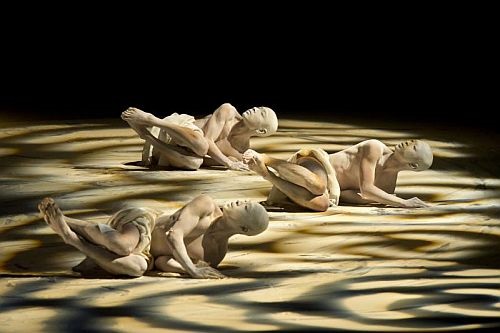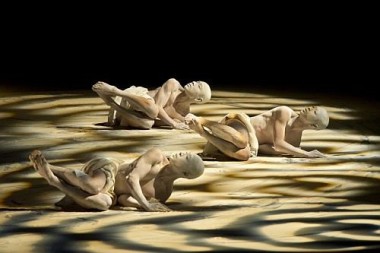 United States Amagatsu: Umusuna – Memories Before History: Sankai Juku, Royce Hall, Los Angeles, 16.10.2015 (JRo)
United States Amagatsu: Umusuna – Memories Before History: Sankai Juku, Royce Hall, Los Angeles, 16.10.2015 (JRo)

Production:
Choreography: Ushio Amagatsu
Music: Takashi Kako, Yas-Kaz, Yoichiro Yoshikawa
Sets and costumes: Ushio Amagatsu
Lighting: Genta Iwamura
Dancers: Ushio Amagatsu, Semimaru, Sho Takeuchi, Akihito Ichihara, Ichiro Hasegawa, Dai Matsuoka, Norihito Ishii, Shunsuke Momoki
Ushio Amagatsu, the founder of the singular dance company Sankai Juku, is not simply a choreographer. He is, as his creation Umusuna illustrates, a visual artist, a poet, and a philosopher.
On a set of starkly modern, sculptural beauty, located at the intersection of Earthworks and Minimalism, Amagatsu grapples with questions of existence. At the center back of the stage, sand rains down in a single column throughout the entire 90 minutes of the dance. The sand corkscrews as it falls, slowly creating a mound as it collects. On either side, at opposite ends, two hanging glass sculptures evoke the weighing pans of a scale and, at the top of each pan, a glass container releases sand in a narrow stream. Throughout the seven dance movements, the black backdrop, against which these sand sculptures are set, is often punctuated by a perpendicular band of white, red, or green light. With the addition of two immense rectangular floors of sand occupying most of the stage, we enter a refined yet primordial world.
The guide for the evening through this plane of existence is Amagatsu himself. He stands, his back to the audience, at the front of the stage. His body and face, from the top of his shaven skull to his toes, is coated in white, and he wears a draped white skirt. Two small streaks of red, which appear to emanate from his ears like blood or gills, are barely perceptible. He moves slowly, accompanied by the sound of cascading sand. His hand reaches out, and his arms rise and fall like bird wings; the upper body movement feels like an ancient, ritualized port de bras.
The white column of light at the center back of the stage changes to a vibrant red and, accompanied by mechanistic sounds, four male dancers, similarly coated in white and wearing vermillion skirts and beige corsets, enter. The corsets startle because, in this primordial context, they imply an exoskeleton. The dancers open their mouths into screams, revealing, in marked contrast to their white faces, gaping black holes. This will be no ordinary evening of dance.
Amagatsu founded Sankai Juku in 1975. His all-male dance company has been centered in Paris at the Théâtre de la Ville for 35 years. Based on the principles of Butoh, a dance form created in the aftermath of World War II in Japan, Amagatsu has deepened and universalized the practice, examining the body’s relationship to the force of gravity and its effects on both body and space.
Throughout the evening, the movements of this committed troupe of artists make reference to traditional forms. Bukagu (ancient court dance) and Tai Chi (Chinese martial art) come to mind with their slow, controlled steps and gestures. But Amagatsu’s choreography occupies a unique place: he makes sculptural dance poetry out of fundamental human questions of being and nothingness. He sets his exploration in the vastness of nature as wind, sand, water, sedimentation, erosion, and vegetation are conjured.
In one powerful section, three dancers lie on their sides in the fetal position, each with his legs interlaced. Every so often a head rises then falls; often their knotted legs lift incongruously off the ground while their upper bodies remain still. It is a birth of sorts – like the hatching of an animal from an egg or an alien life form struggling into existence in a laboratory. It is a frightening image, evoking mankind writhing within the primordial soup of creation as seen with a detached eye.
In the most “civilized” section, dancers dressed in white robes overlaid with aquamarine panels seem to transcend their primal selves to a higher state of existence, becoming monks or ancient gods in an ethereal realm. We leave the mechanistic music behind and hear a florid sound rise with the wisp of melody. As they dance, their feet stir the sand, which floats in dusty clouds.
Towards the end of the evening, Amagatsu returns alone to the stage to the vibration of desert winds and swirling sand. A white column of light materializes at the back center of the stage, and Amagatsu retreats into the light. It seems a fitting conclusion to this awe-inspiring evening, but instead, on his exit, the entire company reappears.
The black curtain slowly parts, leaving the stage awash with white light. Against this translucent backdrop, the white-bodied dancers move once again – this time in positions of prayer. The dancers are illuminated, and we, the audience, find ourselves illuminated as well.
Jane Rosenberg
